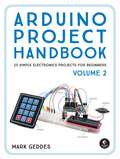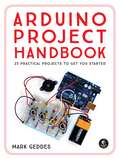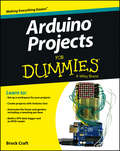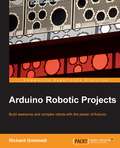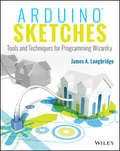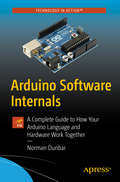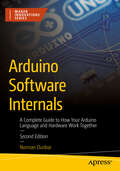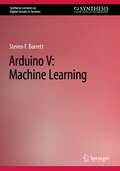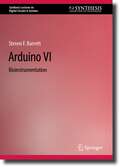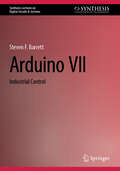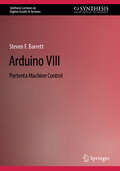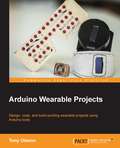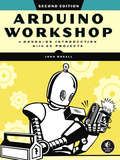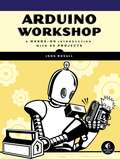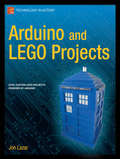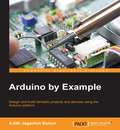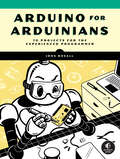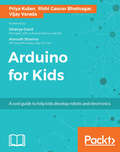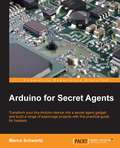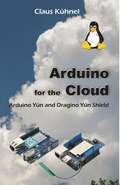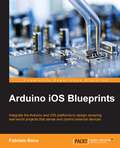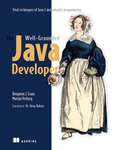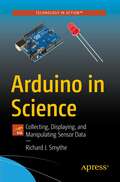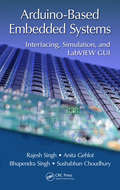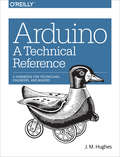- Table View
- List View
Arduino Project Handbook, Volume 2: 25 Simple Electronics Projects for Beginners
by Mark GeddesThis second volume of the Arduino Project Handbook delivers 25 more beginner-friendly electronics projects. Get up and running with a crash course on the Arduino, and then pick any project that sparks your interest and start making! Each project includes cost and time estimates, simple instructions, colorful photos and circuit diagrams, a troubleshooting section, and the complete code to bring your build to life. With just the Arduino board and a handful of components, you’ll make gadgets like a rainbow light display, noise-level meter, digital piano, GPS speedometer, and fingerprint scanner. This collection of projects is a fast and fun way to get started with microcontrollers that’s perfect for beginners, hobbyists, parents, and educators.25 Step-by-Step ProjectsLED Light BarLight-Activated Night-LightSeven-Segment LED Countdown TimerLED Scrolling MarqueeMood LightRainbow Strip LightNeoPixel CompassArduino PianoAudio LED VisualizerOld-School Analog DialStepper MotorTemperature-Controlled FanUltrasonic Range FinderDigital ThermometerBomb Decoder GameSerial LCD ScreenUltrasonic People CounterNokia 5110 LCD Screen Pong GameOLED BreathalyzerUltrasonic SoakerFingerprint ScannerUltrasonic RobotInternet-Controlled LEDVoice-Controlled LEDGPS SpeedometerUses the Arduino Uno board Praise for the first volume of Arduino Project Handbook:"Easily the best beginner’s guide out there. Pair with an inexpensive clone-based starter kit, and it’s never been cheaper to join the maker revolution."—MakeUseOf.com"Beautifully designed."—Boing Boing
Arduino Project Handbook: 25 Practical Projects to Get You Started
by Mark GeddesArduino Project Handbook is a beginner-friendly collection of electronics projects using the low-cost Arduino board. With just a handful of components, an Arduino, and a computer, you’ll learn to build and program everything from light shows to arcade games to an ultrasonic security system.First you’ll get set up with an introduction to the Arduino and valuable advice on tools and components. Then you can work through the book in order or just jump to projects that catch your eye. Each project includes simple instructions, colorful photos and circuit diagrams, and all necessary code.Arduino Project Handbook is a fast and fun way to get started with microcontrollers that’s perfect for beginners, hobbyists, parents, and educators.Uses the Arduino Uno board.
Arduino Projects For Dummies
by Brock CraftDiscover all the amazing things you can do with ArduinoArduino is a programmable circuit board that is being used by everyone from scientists, programmers, and hardware hackers to artists, designers, hobbyists, and engineers in order to add interactivity to objects and projects and experiment with programming and electronics. This easy-to-understand book is an ideal place to start if you are interested in learning more about Arduino's vast capabilities. Featuring an array of cool projects, this Arduino beginner guide walks you through every step of each of the featured projects so that you can acquire a clear understanding of the different aspects of the Arduino board.Introduces Arduino basics to provide you with a solid foundation of understanding before you tackle your first projectFeatures a variety of fun projects that show you how to do everything from automating your garden's watering system to constructing a keypad entry system, installing a tweeting cat flap, building a robot car, and much moreProvides an easy, hands-on approach to learning more about electronics, programming, and interaction design for Makers of all agesArduino Projects For Dummies is your guide to turning everyday electronics and plain old projects into incredible innovations.Get Connected! To find out more about Brock Craft and his recent Arduino creations, visit www.facebook.com/ArduinoProjectsForDummies
Arduino Robotic Projects
by Richard GrimmettThis book is for anyone who has been curious about using Arduino to create robotic projects that were previously the domain of research labs of major universities or defense departments. Some programming background is useful, but if you know how to use a PC, you can, with the aid of the step-by-step instructions in this book, construct complex robotic projects that can roll, walk, swim, or fly.
Arduino Sketches
by James A. LangbridgeMaster programming Arduino with this hands-on guideArduino Sketches is a practical guide to programming the increasingly popular microcontroller that brings gadgets to life. Accessible to tech-lovers at any level, this book provides expert instruction on Arduino programming and hands-on practice to test your skills. You'll find coverage of the various Arduino boards, detailed explanations of each standard library, and guidance on creating libraries from scratch - plus practical examples that demonstrate the everyday use of the skills you're learning. Work on increasingly advanced programming projects, and gain more control as you learn about hardware-specific libraries and how to build your own. Take full advantage of the Arduino API, and learn the tips and tricks that will broaden your skillset.The Arduino development board comes with an embedded processor and sockets that allow you to quickly attach peripherals without tools or solders. It's easy to build, easy to program, and requires no specialized hardware. For the hobbyist, it's a dream come true - especially as the popularity of this open-source project inspires even the major tech companies to develop compatible products. Arduino Sketches is a practical, comprehensive guide to getting the most out of your Arduino setup. You'll learn to:Communicate through Ethernet, WiFi, USB, Firmata, and XbeeFind, import, and update user libraries, and learn to create your ownMaster the Arduino Due, Esplora, Yun, and Robot boards for enhanced communication, signal-sending, and peripheralsPlay audio files, send keystrokes to a computer, control LED and cursor movement, and moreThis book presents the Arduino fundamentals in a way that helps you apply future additions to the Arduino language, providing a great foundation in this rapidly-growing project. If you're looking to explore Arduino programming, Arduino Sketches is the toolbox you need to get started.
Arduino Software Internals: A Complete Guide to How Your Arduino Language and Hardware Work Together
by Norman DunbarIt’s not enough to just build your Arduino projects; it’s time to actually learn how things work! This book will take you through not only how to use the Arduino software and hardware, but more importantly show you how it all works and how the software relates to the hardware.Arduino Software Internals takes a detailed dive into the Arduino environment. We’ll cover the Arduino language, hardware features, and how makers can finally ease themselves away from the hand holding of the Arduino environment and move towards coding in plain AVR C++ and talk to the microcontroller in its native language. What You’ll Learn:How the Arduino Language interfaces with the hardware, as well as how it actually works in C++;How the compilation system works, and how kit can be altered to suit personal requirements;A small amount of AVR Assembly Language;Exactly how to set up and use the various hardware features of the AVR without needing to try and decode the data sheets – which are often bug ridden and unclear;Alternatives to the Arduino IDE which might give them a better workflow;How to build their own Arduino clone from scratch.Who This Book Is For: No expertise is required for this book! All you need is an interest in learning about what you’re making with Arduinos and how they work. This book is also useful for those looking to understand the AVR microcontroller used in the Arduino boards. In other words, all Makers are welcome!
Arduino Software Internals: A Complete Guide to How Your Arduino Language and Hardware Work Together (Maker Innovations Series)
by Norman Dunbar"It's not enough to just build your Arduino projects; it's time to actually learn how things work!" This book goes beyond the basics, providing a comprehensive understanding of Arduino software and hardware, as well as how they intertwine. Gain valuable insights into the inner workings of Arduino and its language, and discover how to communicate with the microcontroller in its native language, AVR C++.Explore the latest version (0.30.0) which offers a multitude of configuration options that can be conveniently modified using the command-line interface (CLI).What You’ll Learn:How the Arduino Language interfaces with the hardware, as well as how it actually works in C++;How to burn bootloaders with the latest version (0.30.0) of Arduino software.How to program your device using an In Circuit System Programmer (ICSP)How to build their own Arduino clone from scratchHow to efficiently handle different boards and libraries Uncover new features and enhancements, including the ability to set up and use profiles, and employ Makefiles.Who This Book Is For: This book welcomes everyone with an interest in learning about Arduino, regardless of expertise. Whether you're a beginner or an experienced Maker, "Arduino Software Internals" equips you with the knowledge to truly comprehend and leverage the power of Arduino.
Arduino V: Machine Learning (Synthesis Lectures on Digital Circuits & Systems)
by Steven F. BarrettThis book is about the Arduino microcontroller and the Arduino concept. The visionary Arduino represented a new innovation in microcontroller hardware in 2005, the concept of open source hardware, making a broad range of computing accessible for all.This book, “Arduino V: AI and Machine Learning,” is an accessible primer on Artificial Intelligence and Machine Learning for those without a deep AI and ML background. The author concentrates on Artificial Intelligence (AI) and Machine Learning (ML) applications for microcontroller–based systems. The intent is to introduce the concepts and allow readers to practice on low cost, accessible Arduino hardware and software. Readers should find this book a starting point, an introduction, to this fascinating field. A number of references are provided for further exploration.
Arduino VI: Bioinstrumentation (Synthesis Lectures on Digital Circuits & Systems)
by Steven F. BarrettThis book is about the Arduino microcontroller and the Arduino concept. The visionary Arduino team represented a new innovation in microcontroller hardware in 2005, the concept of open source hardware, making a broad range of computing accessible for all. This book, “Arduino VI: Bioinstrumentation,” is an accessible primer on bioinstrumentation for those without a deep instrumentation background. An understanding of basic circuit theory is an appropriate prerequisite for the book. The three main goals for the book are: explore accessible Arduino microcontroller programming and interfacing concepts; investigate the source and measurement of biomedical signals; and develop skills to design and implement biomedical instrumentation.
Arduino VII: Industrial Control (Synthesis Lectures on Digital Circuits & Systems)
by Steven F. BarrettThis book is about the Arduino microcontroller and the Arduino concept. The visionary Arduino represented a new innovation in microcontroller hardware in 2005, the concept of open source hardware, making a broad range of computing accessible for all. This book, “Arduino VII: Industrial Control,” is an accessible primer on industrial control and programmable logic controller concepts for those without a deep instrumentation background. An understanding of basic circuit theory is an appropriate prerequisite for the book. The three main goals for the book are: explore accessible Arduino Opta industrial control products; learn the fundamentals of programming using ladder logic; and explore related sensors and interface concepts. We use multiple examples throughout the book and conclude with an instrumented greenhouse project.
Arduino VIII: Portenta Machine Control (Synthesis Lectures on Digital Circuits & Systems)
by Steven F. BarrettThis book is about the Arduino microcontroller and the Arduino concept. The visionary Arduino represented a new innovation in microcontroller hardware in 2005, the concept of open source hardware, making a broad range of computing accessible for all. This book, &“Arduino VIII: Portenta Machine Control,&” is an accessible primer on industrial control and programmable logic controller concepts for those without a deep instrumentation background. An understanding of basic circuit theory is an appropriate prerequisite for the book. The three main goals for the book are: explore accessible Arduino Portenta Machine Control industrial control products; learn the fundamentals of programming using ladder logic; and explore related sensors and interface concepts. We use multiple examples throughout the book and conclude with an instrumented greenhouse project.
Arduino Wearable Projects
by Tony OlssonDesign, code, and build exciting wearable projects using Arduino tools About This Book * Develop an interactive program using sensors and actuators suitable with wearables * Understand wearable programming with the help of hands-on projects * Explore different wearable design processes in the Arduino platform and customize them to fit your individual needs Who This Book Is For This book is intended for readers who are familiar with the Arduino platform and want to learn more about creating wearable projects. No previous experience in wearables is expected, although a basic knowledge of Arduino programming will help. What You Will Learn * Develop a basic understanding of wearable computing * Learn about Arduino and its compatible prototyping platforms suitable for creating wearables * Understand the design process surrounding the creation of wearable objects * Gain insight into the materials suitable for developing wearable projects * Design and create projects including interactive bike gloves, GPRS locator watch, and more using various kinds of electronic components * Discover programming for interactivity * Learn how to connect and interface wearables' with Bluetooth and WiFi * Get your hands dirty with your own personalized designs In Detail The demand for smart wearable technologies is becoming more popular day by day. The Arduino platform was developed keeping wearables, such as watches that track your location or shoes that count the miles you've run, in mind. It is basically an open-source physical computing platform based on a simple microcontroller board and a development environment in which you create the software for the board. If you're interested in designing and creating your own wearables, this is an excellent platform for you. This book provides you with the skills and understanding to create your own wearable projects. The book covers different prototyping boards which are compatible with the Arduino platform and are suitable for creating wearable projects. Each chapter of the book covers a project in which knowledge and skills are introduced gradually, making the book suitable for all kinds of readers. You begin your journey with understanding electronic components, including LEDs and sensors, to get yourself up to scratch and comfortable with different components. You will then gain hands-on experience by creating your very first wearable project, a pair of interactive bike gloves that help you cycle at night. This is followed by a project making your own funky LED glasses and a cool GPS watch. You'll also delve into other projects including creating your own keyless doorlock, wearable NFC tags, a fitness-tracking device, and a WiFi-enabled spark board. The final project is a compilation of the previous concepts used where you make your own smart watch with fitness tracking, internet-based notifications, GPS, and of course time telling. Style and approach This is a project-based book that introduces each project to the reader step-by-step. Each project starts out by covering all the components individually, and then explains how to combine them into interactive objects. Each project contains an easy-to-follow guide to design and implement the electronics into wearable objects.
Arduino Workshop, 2nd Edition: A Hands-on Introduction with 65 Projects
by John BoxallLong-awaited revision of this best-selling book on the Arduino electronics platform (35,000+ copies sold). Readers gain an in-depth understanding of the Arduino -- beyond just making simple projects.The Arduino is an inexpensive, flexible microcontroller platform that makes it easy for hobbyists to use electronics in DIY projects. With its wide range of input and output add-ons, sensors, indicators, displays, and motors, the Arduino offers you countless ways to create interactive devices. Through 65 hands-on projects, Arduino Workshop will teach you the tricks and design principles of a master craftsman. This edition has been updated for the latest version of the Arduino IDE and revised to reflect current hardware and technology. It includes coverage of general electronics concepts as well as schematic diagrams and detailed images of components. You&’ll experiment with touchscreens and LED displays, explore robotics, use sensors with wireless data links, and control devices remotely with a cell phone. Build projects like: • An electronic version of the classic six-sided die • A GPS logger that records and displays travel data • A keypad-controlled lock that opens with a secret code • A binary quiz game • A motorized remote control car with collision detection Whatever your skill level, you&’re sure to have fun as you learn to harness the power of the Arduino for your own DIY projects. NEW TO THIS EDITION: • A chapter on creating your own Arduino libraries • Updated robotic vehicle projects • Newer shields that leverage GPS, 3G, and LoRa data transmission capabilities • A chapter on MAX7219-based numeric LED displays and LED matrix modules Covers Arduino IDE 2.x
Arduino Workshop: A Hands-On Introduction with 65 Projects
by John BoxallThe Arduino is a cheap, flexible, open source microcontroller platform designed to make it easy for hobbyists to use electronics in homemade projects. With an almost unlimited range of input and output add-ons, sensors, indicators, displays, motors, and more, the Arduino offers you countless ways to create devices that interact with the world around you.In Arduino Workshop, you'll learn how these add-ons work and how to integrate them into your own projects. You'll start off with an overview of the Arduino system but quickly move on to coverage of various electronic components and concepts. Hands-on projects throughout the book reinforce what you've learned and show you how to apply that knowledge. As your understanding grows, the projects increase in complexity and sophistication.Among the book's 65 projects are useful devices like:– A digital thermometer that charts temperature changes on an LCD–A GPS logger that records data from your travels, which can be displayed on Google Maps– A handy tester that lets you check the voltage of any single-cell battery– A keypad-controlled lock that requires a secret code to openYou'll also learn to build Arduino toys and games like:– An electronic version of the classic six-sided die– A binary quiz game that challenges your number conversion skills– A motorized remote control tank with collision detection to keep it from crashingArduino Workshop will teach you the tricks and design principles of a master craftsman. Whatever your skill level, you'll have fun as you learn to harness the power of the Arduino for your own DIY projects.Uses the Arduino Uno board
Arduino and LEGO Projects
by Jon LazarWe all know how awesome LEGO is, and more and more people are discovering how many amazing things you can do with Arduino. In Arduino and LEGO Projects, Jon Lazar shows you how to combine two of the coolest things on the planet to make fun gadgets like a Magic Lantern RF reader, a sensor-enabled LEGO music box, and even an Arduino-controlled LEGO train set. Learn that SNOT is actually cool (it means Studs Not on Top) See detailed explanations and images of how everything fits together Learn how Arduino fits into each project, including code and explanations Whether you want to impress your friends, annoy the cat, or just kick back and bask in the awesomeness of your creations, Arduino and LEGO Projects shows you just what you need and how to put it all together.
Arduino by Example
by Adith Jagadish BoloorDesign and build fantastic projects and devices using the Arduino platform About This Book * Explore the different sensors that can be used to improve the functionality of the Arduino projects * Program networking modules in conjunction with Arduino to make smarter and more communicable devices * A practical guide that shows you how to utilize Arduino to create practical, useful projects Who This Book Is For This book is an ideal choice for hobbyists or professionals who want to create quick and easy projects with Arduino. As a prerequisite, readers must have a working Arduino system and some programming background, ideally in C/C++. Basic knowledge of Arduino is helpful but not required to follow along with this book. What You Will Learn * Understand and utilize the capabilities of the Arduino * Integrate sensors to gather environmental data and display this information in meaningful ways * Add modules such as Bluetooth and Wi-fithat allow the Arduino to communicate and send data between devices * Create simple servers to allow communication to occur * Build automated projects including robots while learning complex algorithms to mimic biological locomotion * Implement error handling to make programs easier to debug and look more professional * Integrate powerful programming tools and software such as Python and Processing to broaden the scope of what the Arduino can achieve * Practice and learn basic programming etiquette In Detail Arduino an opensource physical computing platform based on a simple microcontroller board, and a development environment for writing software for the board. The opensource Arduino software (IDE) makes it easy to write code and upload it to the board. It runs on Windows, Mac OS X, and Linux. The environment is written in Java and based on Processing and other opensource software. With the growing interest in home-made, weekend projects among students and hobbyists alike, Arduino offers an innovative and feasible platform to create projects that promote creativity and technological tinkering. Arduino by Example is a project-oriented guide to help you fully utilize the power of one of the world's most powerful open source platforms, Arduino. This book demonstrates three projects ranging from a home automation project involving your lighting system to a simple robotic project to a touch sensor project. You will first learn the basic concepts such as how to get started with the Arduino, and as you start building the project, you will develop the practical skills needed to successfully build Arduino powered projects that have real-life implications. The complexity of the book slowly increases as you complete a project and move on to the next. By the end of this book, you will be able to create basic projects and utilize the elements used in the examples to construct your own devices. Style and approach This book follows a project-oriented approach, with multiple images and plenty of code to help you build your projects easily. The book uses a tutorial-based methodology where the concepts are first explained and then implemented to help you develop the projects.
Arduino for Arduinians: 70 Projects for the Experienced Programmer
by John BoxallGuided by an expert craftsman with over 30 years of experience, you&’ll build 70 awesome Arduino projects and emerge a true Arduinian ready to invent your own complex creations.For Arduino programmers who&’ve mastered the basics, this book is the next step toward becoming an expert Arduinian. You&’ll build 70 complex and practical projects with this versatile microcontroller platform and gain advanced skills to design reliable, professional, user-friendly creations.You&’ll remote-control your Arduino via Bluetooth and instant messaging, improve the accuracy of clock projects with internet time servers, and automatically turn your Arduino off when it completes a task. You&’ll safely control AC mains power and higher currents and conserve battery with low-power and sleep modes. You&’ll also use Charlieplexing to control LED matrix displays, keep your Arduino running with a watchdog timer, communicate over longer wired distances with the RS232 and RS485 buses, and much more.Along the way, you&’ll build fun and useful devices like:• A camera-enabled circuit to stream videos• An MP3 player to listen to audio of your choice• A CAN bus circuit to gather speed and engine data from your car• A web server to display data captured with an ESP32 board• A PS/2 keyboard to improve your user interfaces and easily enter and display dataGuided by an Arduino master, you&’ll harness dozens of sensors, motors, displays, and techniques to bring your own expert inventions to life.Requirements: Arduino Uno and other Arduino-compatible microcontrollers andUSBasp programmers. Some projects may require other inexpensive parts.
Arduino for Kids
by Priya Kuber Rishi Gaurav Bhatnagar Vijay VaradaA cool guide to help kids develop robots and electronics About This Book • Get clearly-written code with descriptions and comments that explain each code section • The book comes with separate code files, one entire program at a time, as well as many diagrams and separate downloadable files that contain colored photos explaining steps in the book • Kids can build multiple projects during the course of the book; by the end, they will have working projects of their own Who This Book Is For This book is for children aged 9 and up, and their parents, who may or may not have a technical background. This book is tailored around the central idea of introducing electronics as a fun and a curiosity-inducing exercise. This book can act as a bonding exercise between parent and child over a single weekend. What You Will Learn • Write simple programs using variables, functions, loops, arrays, and libraries • Set up the Arduino and understand its internal functioning • Get to grips with connections in electronics and arrive at ways to connect various components yourself • Delve into various sensors and their selection and build your own sensor • Unravel the concept of resistors and capacitors along with understanding the physics of electronics • Become an inventor through interactive exercises (such as making a friend happy with a proximity sensor, and giving "life" to a plant) In Detail The mission of this book is to integrate technology with the tools that children already use for crafts so that they feel that the technology is an extension of their playtime. We use coding, sensors, and micro-controllers integrated with art and craft supplies, origami, and Playdough. There are 10 fun-filled chapters that talk to children directly, and give clear instructions for non-technical parents too. We use Arduino as the controller of choice due to its easy availability and large community. By the end of the book, children will comfortably be able to set up their Arduino, read and understand code, manipulate code, and ultimately write their own code for projects. They will also be able to use basic sensors and know how components connect to each other. All the learning takes place with lots of colorful pictures and the circuits are neatly presented using wiring. Style and approach This book will show you the glamour of common and easily available sensors, so that kids and parents waste no time searching for parts. We provide simple yet fun projects with step-by-step instructions that make it easy to get hands-on.
Arduino for Secret Agents
by Marco SchwartzTransform your tiny Arduino device into a secret agent gadget to build a range of espionage projects with this practical guide for hackers About This Book * Discover the limitless possibilities of the tiny Arduino and build your own secret agent projects * From a fingerprint sensor to a GPS Tracker and even a robot- learn how to get more from your Arduino * Build nine secret agent projects using the power and simplicity of the Arduino platform Who This Book Is For This book is for Arduino programmers with intermediate experience of developing projects, and who want to extend their knowledge by building projects for secret agents. It would also be great for other programmers who are interested in learning about electronics and programming on the Arduino platform. What You Will Learn * Get to know the full range of Arduino features so you can be creative through practical projects * Discover how to create a simple alarm system and a fingerprint sensor * Find out how to transform your Arduino into a GPS tracker * Use the Arduino to monitor top secret data * Build a complete spy robot! * Build a set of other spy projects such as Cloud Camera and Microphone System In Detail Q might have Bond's gadgets- but he doesn't have an Arduino (not yet at least). Find out how the tiny Arduino microcomputer can be used to build an impressive range of neat secret agent projects that can help you go undercover and get to grips with the cutting-edge of the world of espionage with this book, created for ardent Arduino fans and anyone new to the powerful device. Each chapter shows you how to construct a different secret agent gadget, helping you to unlock the full potential of your Arduino and make sure you have a solution for every tricky spying situation. You'll find out how to build everything from an alarm system to a fingerprint sensor, each project demonstrating a new feature of Arduino, so you can build your expertise as you complete each project. Learn how to open a lock with a text message, monitor top secret data remotely, and even create your own Arduino Spy Robot, Spy Microphone System, and Cloud Spy Camera This book isn't simply an instruction manual - it helps you put your knowledge into action so you can build every single project to completion. Style and approach This practical reference guide shows you how to build various projects with step-by-step explanations on each project, starting with the assembly of the hardware, followed by basics tests of all those hardware components and finally developing project on the hardware.
Arduino for the Cloud: Arduino Yun and Dragino Yun Shield
by Claus KuhnelArduino for the Cloud considers the Arduino Yun and the Dragino Yun Shield as components closing the gap between a typical microcontroller application and connection to the cloud. Arduino Yun combines the classic Arduino with an Atheros AR9331 system-on-a-chip (SoC) for wireless access points and routers platforms, which uses the Linux distribution Linino (OpenWRT) operating system. The Dragino Yun Shield expands any Arduino with network capabilities by the Atheros AR9331.The combination of microcontroller and Linux device supports the whole chain from sensor to software applications in the cloud by hardware and software. This book deals with the Arduino and the Linux device and their interaction, without the need of detailed Linux knowledge.
Arduino iOS Blueprints
by Fabrizio BocoIntegrate the Arduino and iOS platforms to design amazing real-world projects to sense and control external devices About This Book * Cover the most widely used methods in the Internet of Things using Arduino and iOS integration through Wi-Fi Shield and the BLE Breakout board * Design five real-world projects including of electronics, Arduino code, and an iOS application that seamlessly work together * A detailed guide that covers various sensors and actuators through which Arduino interacts with the world including a light sensor, hall effect sensor, accelerometer, servo motor, DC motor, and TRIAC for power line loads Who This Book Is For This book is a technical guide for Arduino and iOS developers who have a basic knowledge of the two platforms but want to learn how to integrate them. The book includes a lot of external references to additional documentation and learning materials, so even if you are less experienced, you can improve your knowledge on the subjects covered. What You Will Learn * Design circuits with Arduino using sensors and actuators * Write code to handle analog and digital sensors with the most used protocols including OneWire, I2C, and SPI) * Store data on SD Card and in EEPROM * Build iOS applications using the MCV pattern and the UIKit components * Allow your applications to control Arduino and its hooked-up devices * Manage TCP/IP, UDP, and Bluetooth BLE communication between Arduino and iOS devices * Make your iOS application take advantage of the sensors available in the iOS devices including accelerometer, gyroscope, and compass * Develop iOS applications that use iBeacons In Detail Arduino and iOS devices have reached wide popularity due to their simple way of use and flexibility. Hence, their integration opens up new opportunities, allowing everyone to build devices that are extremely useful in everyday life. You will first learn how to control Arduino from an iPhone or iPad by writing the Arduino sketch, the iOS application, and integrating everything together via Wi-Fi or Bluetooth BLE. You will then learn about various components that interact with the Arduino such as digital and analog I/O, Wi-Fi shield, Bluetooth BLE, SD card, OneWire, I2C, and so on. You will also learn about iOS, which includes the development of an application from scratch, GUI design and MVC, UIKit, iOS sensors, TCP and Bluetooth BLE communication, and more. All the projects are described in detail, providing you with a learning tool, not just some sketches or some iOS code to copy. Style and approach This is a project-based book with a step-by-step guide that covers everything that you need to build an Arduino-iOS project, right from defining the basic requirements to the coding and testing the entire project. Each chapter ends with ideas on how to improve the project and to constantly learn the topics covered.
Arduino in Action
by Joshua Noble Martin Evans Jordan HochenbaumSummaryArduino in Action is a hands-on guide to prototyping and building electronics using the Arduino platform. Suitable for both beginners and advanced users, this easy-to-follow book begins with the basics and then systematically guides you through projects ranging from your first blinking LED through connecting Arduino to devices like game controllers or your iPhone.About the TechnologyArduino is an open source do-it-yourself electronics platform that supports a mind-boggling collection of sensors and actuators you can use to build anything you can imagine. Even if you've never attempted a hardware project, this easy-to-follow book will guide you from your first blinking LED through connecting Arduino to your iPhone.About this BookArduino in Action is a hands-on guide to prototyping and building DIY electronics. You'll start with the basics—unpacking your board and using a simple program to make something happen. Then, you'l attempt progressively more complex projects as you connect Arduino to motors, LCD displays, Wi-Fi, GPS, and Bluetooth. You'll explore input/output sensors, including ultrasound, infrared, and light, and then use them for tasks like robotic obstacle avoidance.Arduino programs look a lot like C or C++, so some programming skill is helpful.What's InsideGetting started with Arduino—no experience required!Writing programs for ArduinoSensing and responding to eventsRobots, flying vehicles, Twitter machines, LCD displays, and more!Purchase of the print book includes a free eBook in PDF, Kindle, and ePub formats from Manning Publications.About the AuthorsMartin Evans is a professional developer, a lifelong electronics enthusiast, and the creator of an Arduino-based underwater ROV. Joshua Noble is an author and creative technologist who works with smart spaces. Jordan Hochenbaum uses Arduino to explore musical expression and creative interaction.Table of ContentsPart 1 Getting startedChapter 1 Hello ArduinoChapter 2 Digital input and outputChapter 3 Simple projects: input and outputPart 2 Putting Arduino to workChapter 4 Extending ArduinoChapter 5 Arduino in motionChapter 6 Object detectionChapter 7 LCD displaysChapter 8 CommunicationsChapter 9 Game onChapter 10 Integrating the Arduino with iOSChapter 11 Making wearablesChapter 12 Adding shieldsChapter 13 Software integration
Arduino in Science: Collecting, Displaying, and Manipulating Sensor Data
by Richard J. SmytheIt’s a simple question, but do you know how to take basic measurements with your Arduino, Raspberry Pi or PC? A lot of the times, you know how to use microcontrollers, sensors, and programming skills to collect data. This book takes it one step further to teach you how to transform your PC, Raspberry Pi, and Arduino to a device that can measure, collect, and analyze data.You'll begin from a simple starting point reviewing the basics of electronics and digital and analog concepts. As you advance through this book, you’ll work through 10 exercises to develop a working knowledge of microcontroller properties and graphical data presentation concepts, basic electronic technology, and the fundamentals of controlling and acquiring data.Arduino in Science is your guide to monitoring and measuring physical – chemical parameters with integrated circuitry and physical computational systems.What You’ll LearnReview fundamental human machine interfacing with supervisory control and data acquisition softwareExamine timing, counting, and serial communication conceptsAdapt microcontrollers to perform sophisticated functionsUnderstand collection and presentation of dataWho This Book Is ForBeginner-level students, citizen scientists, and hobbyists, and is also great for educators who can seamlessly implement this content into STEM programs.
Arduino-Based Embedded Systems: Interfacing, Simulation, and LabVIEW GUI
by Rajesh Singh Sushabhan Choudhury Anita Gehlot Bhupendra SinghArduino is an open-source electronics platform based on easy-to-use hardware and software while LabVIEW is a graphical programming telling how to connect functions and work with a variety of datatypes when constructing applications.This book will help beginners to get started with Arduino-based embedded systems including essential know-how of the programming and interfacing of the devices. Book includes programming and simulation of Arduino-based projects and interfacing with LabVIEW, based on practical case studies. The book comprises of total twenty five chapters with description, working model of LabVIEW and programming with Arduino IDE.
Arduino: A Handbook for Technicians, Engineers, and Makers
by J. M. HughesRather than yet another project-based workbook, Arduino: A Technical Reference is a reference and handbook that thoroughly describes the electrical and performance aspects of an Arduino board and its software.This book brings together in one place all the information you need to get something done with Arduino. It will save you from endless web searches and digging through translations of datasheets or notes in project-based texts to find the information that corresponds to your own particular setup and question.Reference features include pinout diagrams, a discussion of the AVR microcontrollers used with Arduino boards, a look under the hood at the firmware and run-time libraries that make the Arduino unique, and extensive coverage of the various shields and add-on sensors that can be used with an Arduino. One chapter is devoted to creating a new shield from scratch.The book wraps up with detailed descriptions of three different projects: a programmable signal generator, a "smart" thermostat, and a programmable launch sequencer for model rockets. Each project highlights one or more topics that can be applied to other applications.
